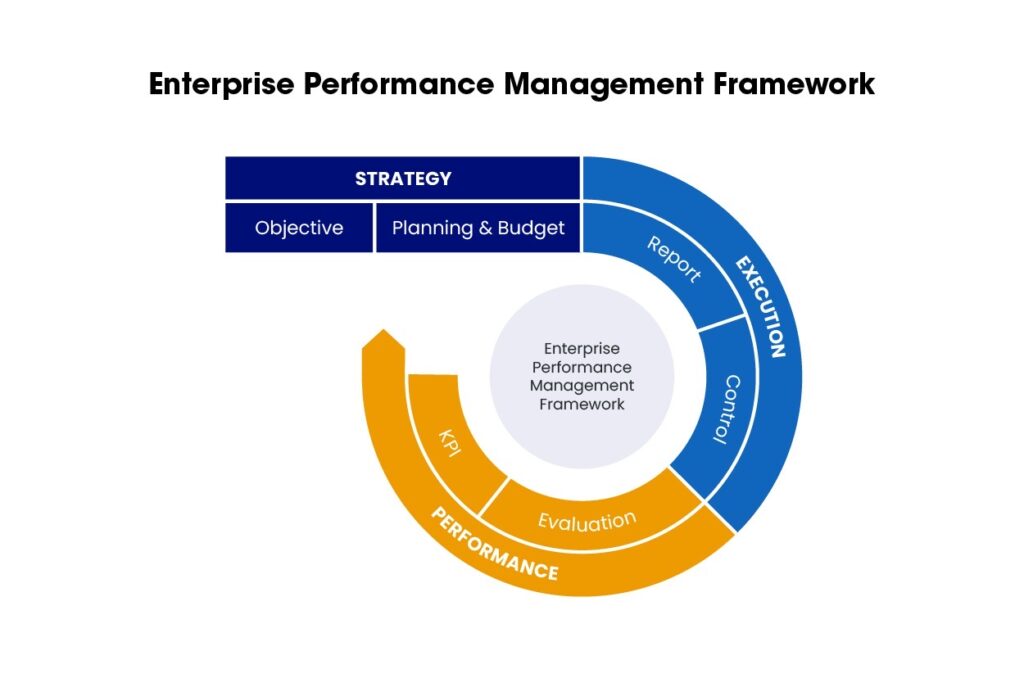All businesses face challenges in achieving sustainable growth, but SMBs struggle more due to limited resources, smaller margins, and less access to capital.
According to the SBA, 20% of small businesses fail within a year, and 50% within five years. Cash flow issues, supply chain inefficiencies, and lack of performance tools can stifle SMB growth.
SMBs can address these challenges through Enterprise Performance Management (EPM) systems, which allow businesses to manage, monitor, and improve performance across all key metrics. EPM enables smaller companies to compete more effectively. As SMBs turn to digital transformation, adopting enterprise performance management could make a major difference in their ability to scale and succeed.
This article will tackle the following:
- Does Enterprise Performance Management for SMBs Work?
- Getting Started with a Strong SMB Enterprise Performance Management Plan
Enterprise performance management is an essential component that impacts the growth and success of small and midsize businesses. EPM involves a calculated strategy that syncs workers’ activities with organizational goals, promoting output and operational effectiveness.
All businesses face challenges in achieving sustainable growth, but SMBs struggle more due to limited resources, smaller margins, and less access to capital.
According to the SBA, 20% of small businesses fail within a year, and 50% within five years. Cash flow issues, supply chain inefficiencies, and lack of performance tools can stifle SMB growth.
SMBs can address these challenges through Enterprise Performance Management (EPM) systems, which allow businesses to manage, monitor, and improve performance across all key metrics. EPM enables smaller companies to compete more effectively. As SMBs turn to digital transformation, adopting enterprise performance management could make a major difference in their ability to scale and succeed.
This article will tackle the following:
- Does Enterprise Performance Management for SMBs Work?
- Getting Started with a Strong SMB Enterprise Performance Management Plan
Enterprise performance management is an essential component that impacts the growth and success of small and midsize businesses. EPM involves a calculated strategy that syncs workers’ activities with organizational goals, promoting output and operational effectiveness.

Performance management is the primary framework SMBs utilize to identify their weaknesses, expansion prospects, and strengths. This step is essential for small businesses as it ensures corporate strategy goals align with day-to-day operations.
Thirty-eight percent (38%) of businesses fail due to cash reserves depletion or not securing additional capital. While the excitement of running your own business is undeniable, many entrepreneurs fall short when it comes to managing capital effectively, often due to a lack of strategic insight and data-driven decision-making.
A mismatch between strategies and actions can lead to inefficiencies and lost opportunities, resulting in stagnation. Hence, businesses must document and record organizational activities and changes to analyze deficiencies and pinpoint opportunities.
EPM software provides insightful data that connects any business’s financial and operational performance. With access to data analytics, companies can make better judgments, formulate more effective plans, and efficiently carry out operations. Gathering and analyzing data from different departments can be vexing, but utilizing EPM enables businesses to project results based on established patterns.
EPM and ERP
EPM is often confused with enterprise resource planning (ERP). ERP software helps businesses organize and standardize procedures by managing data across several departments. ERP platforms let you integrate numerous apps to manage different areas, such as financial order management software, and save data in a single hub.
As mentioned, EPM software examines and analyzes business data and performance to improve overall decision-making. However, both strategies can be combined to create a single source of business insights. Both software can remove or avoid errors while gathering critical business development reports.
Does Enterprise Performance Management for SMBs Work?
EPM drives growth by enhancing company performance and employee development.
Many SMB managers can handle employee evaluations and feedback informally. After all, among the roughly 6 million small businesses in the US with employees, 49% have just one to four workers.
A comprehensive enterprise performance management software suite can assist company expansion by helping the workforce and its departments set clear objectives and track progress. This alignment ensures that staff goals align with the company’s strategic vision to drive collective success and support the organization’s overall mission.
In addition, performance management promotes personnel development through regular check-ins and constructive feedback. Employees can refine their work style, build on their strengths, and address any weaknesses hindering their productivity.
Standardizing the process with an EPM increases employer transparency, builds employee trust, yields more input, and provides valuable insights. SMEs can benefit from a performance management system if their peers, managers, and workers understand and engage with the company’s framework and parameters.
Getting Started with a Strong SMB Enterprise Performance Management Plan
Integrating EPM is easier for SMBs, as it involves fewer employees. Key steps include setting objectives and tracking progress.
SMEs that successfully link strategy with operations and establish clear metrics can better navigate challenges and drive sustainable growth. Here are tips to get you started with an EPM plan.

Identify Your Business Performance Goals
Start by defining clear business goals that align with your strategy. These goals are a foundation for identifying critical success factors (CSFs). CSFs are key actions your business must focus on to meet objectives. For instance, if a restaurant aims to increase sales, a critical success factor might be ensuring exceptional customer service.
Identify CSFs to prioritize key activities and set ‘SMART’ goals—specific, measurable, attainable, realistic, and time-bound—to enhance performance.
Select Your Key Performance Indicators (KPIs).
Once you’ve established your business goals and decided on the steps to achieve them, assess your progress using KPIs or key performance indicators.
An enterprise performance management framework can employ various measures and metrics depending on the department and activity. For example, in human resources, KPI might track employee turnover rates, while in customer service, performance could be measured by average response times.
For metrics to truly drive improvement, ensure your metrics are collaborative. Simply dictating performance targets and KPIs to employees isn’t the optimal way to develop engaged workers devoted to enhancing corporate performance. Employees can often be in the dark and disengaged if they are not involved in discussing the areas that need improvement.
Your team will have the most in-depth knowledge of daily operations and customer needs. Involving them in the evaluation process can drive everyone to identify key areas of improvement and suggest actionable metrics to track.
Encourage an Open-door Policy for Communication
Open communication fosters trust and idea-sharing, creating a collaborative environment for improvement.
Effective communication and collaboration go hand in hand. By encouraging an open-door policy, companies create a more engaged and proactive workforce that ensures that everyone works together toward common goals.
Integrate Digital Management Solutions
Modern BI systems automate tasks, freeing up time for strategic work. Many enterprise performance management systems collect performance data to perform predictive analytics, improve planning, contextualize data versus external sources, and gain insights into real-time performance.
While the initial cost might seem prohibitive to SMEs, EPM software can save time and money by leveraging real-time quantitative and qualitative data to assist in intelligent decision-making. This crucial data helps SMEs become more resilient and competitive by improving their response rate, planning, and adjusting to unforeseen challenges.
Thrive for Continuous Improvement
It is vital to keep adjusting your EPM procedures and operations to boost company performance.
By documenting changes, you can track the impact of business modifications on subsequent procedures and activities. This makes it easier to identify which changes have positively or negatively affected company performance. Successful EPM involves continuous improvement, evolving strategies, and achieving goals.
Implementing enterprise performance management is advantageous for small and midsized businesses in navigating today’s increasingly unpredictable global market. Globalization intensified competition and reduced profit margins. At the same time, customers want a company to be socially and environmentally conscious. Hence, innovation is now necessary for survival rather than just an option for growth.
“Aratum’s EPM solutions future-proof your business with complete visibility and KPI monitoring in one dashboard. Book a demo to see how we can boost your SMB’s resilience.
The featured photo of this article was sourced from rawpixel.com on freepik


